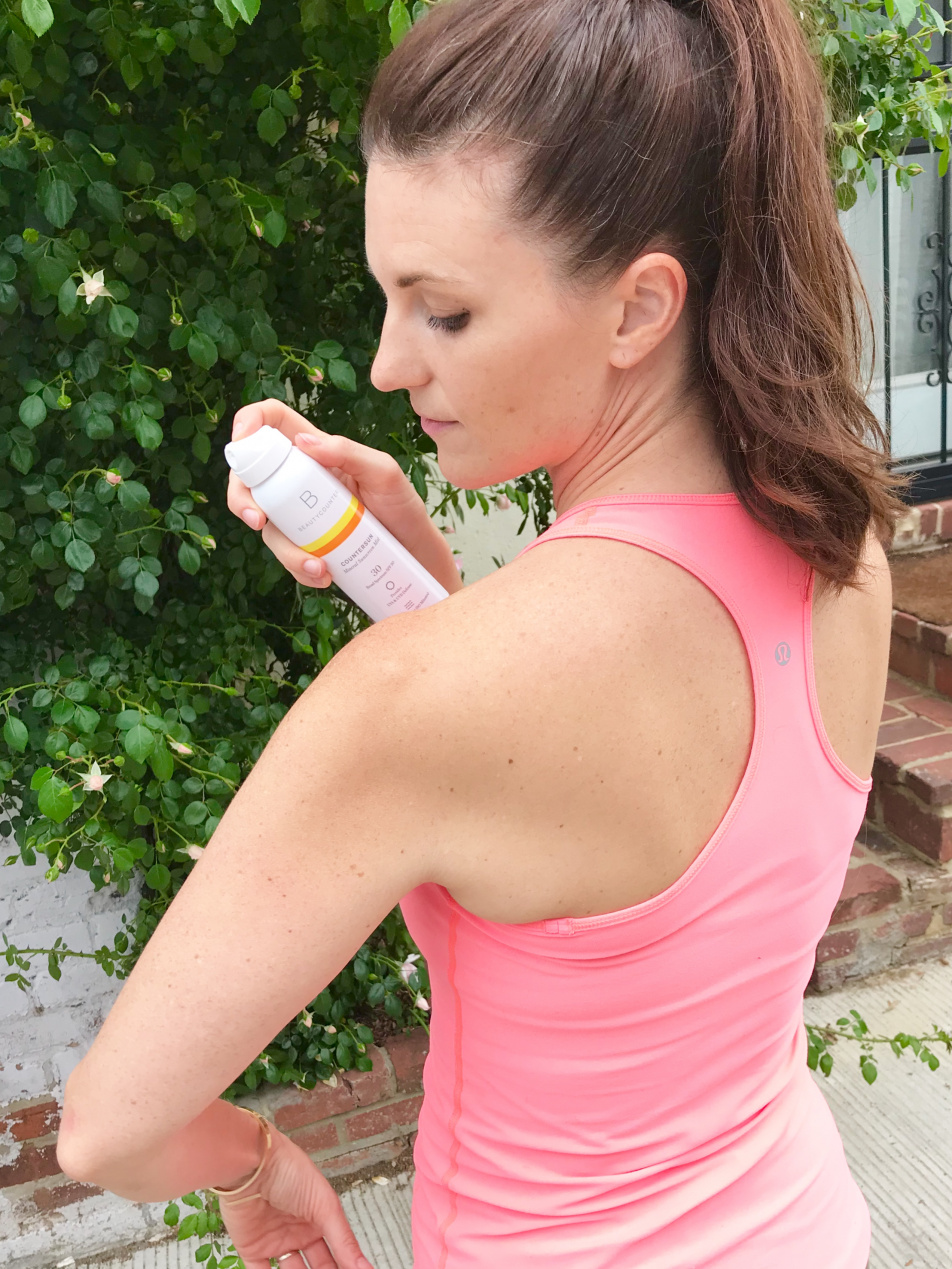Welcome back to Beauty School! As I’m learning more about ingredients in beauty products, I’m sharing my learnings and thoughts with you.
May is Skin Cancer Awareness Month, so it’s a good time to take a refresher course on sunscreen. Unfortunately, skin cancer is on the rise with melanoma as the second most common cancer in women 15 to 29. Now, when I was younger, I was in a tanning bed and trying to turn my pale Irish skin into a golden bronze {even though ‘lobster’ is the only shade I actually achieved}. But we’re smarter ladies today and those stunts aren’t doing us any favors in the long run. Here is what you need to protect your skin and still enjoy the sun.
THE MOST BURNING QUESTIONS ABOUT SUNSCREEN

^^Applying the Countersun Mineral Sunscreen Mist (Travel Size)
What kinds of sunscreens are out there?
There are two types: Chemical and Physical. Chemical is the most common sunscreen out there. As the name suggests, they contain chemicals in the formula to keep you from burning. These chemicals include Octylcrylen, Avobenzone, Oxbenzone and Octinoxate. Here, UV rays enter the skin and the chemicals absorb the light rays. Bottles won’t be labeled as chemical, so if you don’t want to read labels, assume it is. When you turn over and read the back, you will typically find percentages associates with amounts, e.g. Avobenzone 3%.
Physical or Mineral sunscreen forms a protective layer on the skin and reflect sun rays. Basically, the light bounces off the body and doesn’t enter the skin. This is typically done with zinc oxide or titanium oxide.
Are they both effective?
Yes. You need to follow the instructions on the individual package – some may say to re-apply after 40 minutes, some 80, some are water resistant and others not. Experts say you should apply a shot glass amount to your body to ensure skin protection.
Are both kinds of sunscreens safe?
The first thing I’ll say is that not wearing sunscreen correctly or at all, is probably the worst damage you can do to your skin. Sunburn is no joke. If you’re outside without it and offered some, use it. The second safest is mineral sunscreens as they don’t contain harmful chemicals. Moving on to chemical sunscreens, the Environmental Working Group {EWG} has determined toxicity levels of their ingredients. The worst offenders are Oxybenzone, Octinoxate, and Homosalate. The chemical Avobenzone is ranked with low concerns – the same level as the effective ingredients in mineral sunscreens.
What should I avoid if I’m trying to use safe ingredients?
Here are a few:
Oxybenzone – A hormone disruptor that impacts the endocrine system in the body. It is also linked to reef bleeching. Hawaii has recently passed a law banning the sale and distribution of sunscreens that contain it. Some sunscreens will note they are “Oxybenzone Free”, so look for those.
Octinoxate – similar to Oxybenzone, and also banned as part of Hawaii’s proposed bill.
Parabens – You can read all about why these are bad here.
Mists and Sprays – An aerosol sunscreen spray will most likely contain propane or isobutane to distribute the product. This is the “flammable” warning on the label. You don’t want to inhale these.
What about SPF?
30 is the way to go. Anything higher is marginally effective. The FDA has even proposed banning sunscreens with a 50+.
OK, what kinds of sunscreen are you using?
I recently ordered the Beautycounter ConterSun Mineral Sunscreen stick. My kids have been huge pains about applying lotion on their faces so a stick form is imperative for the family. This will be my daily sunscreen. I did use the original sunscreen lotion while in Florida and I learned the hard way that you truly need to follow directions with sunscreen. The lotion has a reapply time of 40 minutes while the mist and the stick are 80, which is better suited when out at the pool all day long. I like the mist as well and love that it uses a non-aerosol formula. Also, I use Dew Skin on my face everyday which has an SPF 20.
Before this year, my go to sunscreens were SunBum, Supergoop and Babyganics. The first two do a pretty good job of not using harmful ingredients. The biggest offender is Octinoxate found in both. I have a few bottles to use up and will save these for longer sun exposure days. Babyganics suncare line up contains mainly mineral options and are generally safe.
Anything else I need to know?
Sunscreen is obviously very important, but it’s not the only way to protect yourself while outside. Wear long sleeves, swim suits with sun protection, take breaks in the shade periodically and wear a hat! Lastly, apply your sunscreen on before heading outside.
What do you do to protect yourself from the sun? Have you tried mineral sunscreens before? And I want to hear from you! What do you want to see more of on Beauty School?


